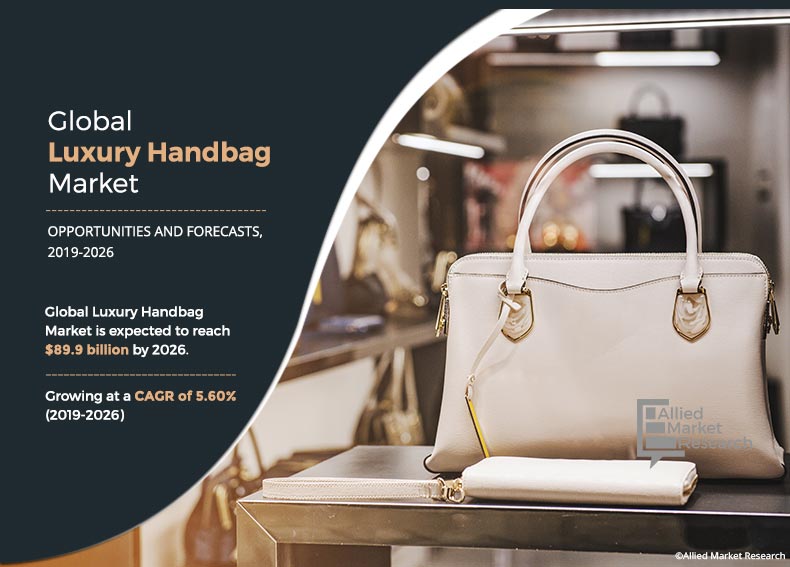
According to a new report published by Allied Market Research titled, “Luxury Handbag Market by Type and Distribution Channel: Global Opportunity Analysis and Industry Forecast, 2019-2026,” the luxury handbag market size was valued at $58.3 billion in 2018 and is expected to reach $89.9 billion by 2026, registering a CAGR of 5.6% from 2019 to 2026. In 2017, Europe accounted for nearly 35.0% share of the luxury handbag market.
Key players profiled for luxury handbag industry include LVMH, Furla SpA, Longchamp, Luxottica Group, Mulberry Group, Vera Bradley, Guccio Gucci S.p.A, Samsonite International S.A./Tumi brand, Valentino S.p.A., and ZV France SAS
Emerging economies, especially in Asia-Pacific, such as India, China, Indonesia, and the Philippines are progressively spending on luxury cosmetic products, owing to increase in disposable income. Consumers in Hong Kong aged 30 to 49 have the highest disposable income and thus, are the biggest buyers of luxury products in the country. Similarly, in India, factors such as emergence of young populace, increase in disposable income, rise in number of working women, and surge in affordability of luxury products are expected to drive the growth of the market. The demand for luxury brands and specialized products is on the rise as Indian consumers gain additional acquaintances with global media and travel more. Several international luxury brands such as Gucci and Louis Vuitton are present in the country for numerous years.
Ask for sample copy of this report :- https://www.alliedmarketresearch.com/request-sample/6362
Furthermore, consumers in Singapore are image conscious and hence, place a high priority on personal accessories. For this reason, international handbag brands that combine revolutionary design with ease of use, continue to dominate the market. Furthermore, consumers in New Zealand, who reside in urban centers, boost increase in disposable income alongside easy accessibility to handbags through retail outlets. Moreover, departmental stores generally specialize in luxury brands and hire assistants to offer advice to consumers. This direct selling approach appeals consumers in the region and boosts the sales of luxury products. Thereby, the market for luxury handbag is witnessing considerable growth in regions such as India, China, and New Zealand.
Multiple taxes such as local tax, import duty, high internal shipment cost, and trade margins cumulatively increase the prices of the imported luxury handbags. Accounting these factors, price of such products for buyers gets extremely high and hence, pricing becomes a major threat for luxury handbags. In countries such as India, where consumers are very price-sensitive, many luxury brands have launched products in smaller quantities to make them affordable.
Interested in Procuring this Report? Visit Here :- https://www.alliedmarketresearch.com/purchase-enquiry/6362
The trade war between the two biggest luxury markets, namely, the U.S. and China, hampers the cosmetic products market since heavy tariffs are levied by either countries on the goods imported. This may especially cause risk to the American luxury brands since the new tariffs may shift the focus of Chinese consumers toward their domestic brands or Korean brands. The fierce trade war between the two major economies is expected to hamper the growth of the luxury market in other massive regions such as Asia.
Premiumization has facilitated a bridge between desirability of luxury experience and necessity of mass market. As a result, it plays a key role in the overall luxury handbag market growth. Currently, customers seek for superior quality and design when it comes to using any kind of consumer good products, including handbag irrespective of its high-end price tags. This results in increase in demand for premium handbag brands.
Most of the developed countries have witnessed surging demand for luxury handbags. This is attributable to the rise in per capita income of target customers, coupled with extended product offerings of luxury handbag manufacturers. Thus, surge in demand for various luxury products triggers growth of global luxury handbag market.
Get detailed COVID-19 impact analysis@ Request For Customization:-https://www.alliedmarketresearch.com/request-for-customization/6362?reqfor=covid
Endorsement of handbags by celebrities is a major driver of the global luxury handbag market growth. Influence of celebrity promotions of handbag has shown positive growth in the overall market in terms of value sales. Celebrity marketed luxury sales have increased significantly, in terms of value, over past five years, specifically in China, Germany, the U.S. and the UK. Hence, celebrity branding and endorsement provides an avenue for the growth of the global luxury handbag market in terms of value sales.
Key Findings of the Study
In 2018, by type , the handbag segment accounted for around higher market share, growing at a CAGR of 5.80% from 2019 to 2026.
In 2018, by distribution channel, the specialty stores segment accounted for higher luxury handbag market share.
In 2018, by region, Europe accounted for a higher value luxury handbag market share.
Similar Report :-
Lab Grown Diamonds Market
Electric Wheelchair Market
David Correa
5933 NE Win Sivers Drive
#205, Portland, OR 97220
United States
USA/Canada (Toll Free):
+1-800-792-5285, +1-503-894-6022
UK: +44-845-528-1300
Hong Kong: +852-301-84916
India (Pune): +91-20-66346060
Fax: +1(855)550-5975
help@alliedmarketresearch.com
Web: www.alliedmarketresearch.com
Allied Market Research Blog: https://blog.alliedmarketresearch.com
Follow Us on | Facebook | Twitter | LinkedIn |